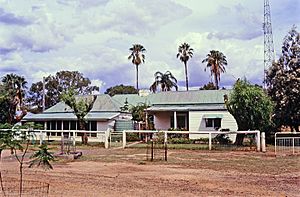Wyaga Homestead facts for kids
Quick facts for kids Wyaga Homestead |
|
|---|---|

Wyaga Homestead
|
|
| Location | Millmerran Road, Wyaga, Goondiwindi Region, Queensland, Australia |
| Design period | 1840s - 1860s (mid-19th century) |
| Built | c. 1862 |
| Official name: Wyaga Homestead | |
| Type | state heritage (built) |
| Designated | 5 May 1995 |
| Reference no. | 600940 |
| Significant period | 1860s (fabric) |
| Significant components | chimney/chimney stack, residential accommodation - main house |
| Lua error in Module:Location_map at line 420: attempt to index field 'wikibase' (a nil value). | |
Wyaga Homestead is a very old and important house located on Millmerran Road in Wyaga, near Goondiwindi in Queensland, Australia. It is known as a "heritage-listed" site, which means it is protected because of its special history and design. The main part of the house was built around 1862. It was added to the Queensland Heritage Register on May 5, 1995, recognizing its value to Queensland's past.
Contents
Wyaga Homestead: A Historic Home
Wyaga is found north-east of Goondiwindi. It is believed to be one of the first large cattle farms in the Darling Downs area. In 1849, a man named David Perrier leased the Wyaga land, which was about 60,000 acres. This was a huge area for raising cattle!
A Look Back in Time
By the late 1850s, Wyaga was owned by Thomas de Lacy Moffatt and W. M. Turner. Thomas Moffatt was an important person. He was a member of the Queensland Parliament from 1860 to 1864. He also served as the Treasurer of Queensland, managing the government's money, from 1862 to 1864.
In 1860, Donald Gunn senior bought Wyaga. The property already had buildings like a woolshed and several small huts. Around 1862, a main house, or homestead, was built for Mr. Gunn. The timber for this house was cut by hand right on the property. The roof was made of wooden shingles, and the builders used square, handmade nails. This shows how people built homes a long time ago, using materials from their own land.
Mr. Gunn sold Wyaga to the Holmes family around 1863. Over the years, the property changed hands many times. Its size also became smaller as parts of the land were sold off. In the 1890s, Thomas Cook and Hugh Munro bought Wyaga. They owned many large farms. After Thomas Cook passed away in 1912, Munro became the sole owner.
In 1913, Munro started a new business partnership with Frederick Charles Turner. They began raising special merino sheep at Wyaga in 1938. Some other buildings, like a new woolshed, were likely built in the 1930s. The partnership ended in 1944, and a new group called the Wyaga Partnership took over. By the 1950s, Wyaga was raising both cattle and sheep. The homestead itself was changed and made bigger, possibly during the 1950s. The Munro family owned Wyaga until 1975, and the current owners bought it in 1982.
What Does It Look Like?
The oldest part of the Wyaga Homestead, built around 1862, has a simple rectangular shape. It has a verandah (an open porch) along the front (western side) and used to have one on the back (eastern side). The rooms at each end of the house have been changed and made larger. However, the central living and dining rooms are still mostly in their original state.
These central rooms have special double doors called French doors. The outer part of these doors has louvres, which are angled slats that let air in but keep sun out. The inner part has glass timber doors. Above these doors are small windows called fanlights. Inside, the walls are covered with wide, painted wooden boards, and the ceilings are also made of wooden boards.
The western wall of the house is made of thick, angled wooden boards called chamferboards. These boards might have been cut using a "pit-saw," a very old way of cutting timber by hand. The verandah on the west side has been covered with flyscreens, but it still has its original, specially shaped verandah posts. The eastern verandah was extended to become part of a large living room. The original verandah posts are now inside this new room. This room connects the old part of the house to the newer additions.
From the western side, you can see the overall shape of the house. It has a unique roof called a gambrel roof, which has two different slopes on each side. This roof is now covered with corrugated iron. A large brick chimney stands tall above the roof.
Why is Wyaga Homestead Important?
Wyaga Homestead is listed on the Queensland Heritage Register because it meets several important rules.
- It shows how Queensland's history developed.
The parts of Wyaga Homestead that are still standing from around 1862 show a rare part of Queensland's history. They teach us about building methods from the 1800s that are not used anymore. Studying these parts of the homestead can help us understand how building technology grew in Queensland.
- It shows rare or endangered parts of Queensland's history.
The old sections of Wyaga Homestead are special because they show building practices from the 19th century that are now very uncommon. This makes the homestead a unique example of how people built homes long ago.
- It can help us learn more about Queensland's history.
Because of its old building methods, the homestead has the potential to give us more information. It can help us understand how building techniques changed and improved over time in Queensland.


